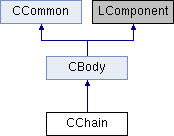 |
Ball and Spring Toy
Ian Parberry's "Introduction to Game Physics"
|
 |
Ball and Spring Toy
Ian Parberry's "Introduction to Game Physics"
|
The chain. More...
#include <Chain.h>

Public Member Functions | |
| CChain (UINT, float, float, float, Vector2) | |
| Constructor. More... | |
 Public Member Functions inherited from CBody Public Member Functions inherited from CBody | |
| void | DeliverImpulse (float) |
| Deliver impulse to body. More... | |
| void | Teleport (const Vector2 &) |
| Magically teleport body by this amount. More... | |
| void | draw () |
| Draw body. More... | |
Additional Inherited Members | |
 Protected Member Functions inherited from CBody Protected Member Functions inherited from CBody | |
| CPoint * | CreatePoint (eSprite, const Vector2 &) |
| Create point. More... | |
| CSpring * | CreateSpring (eSprite, CPoint *, CPoint *, float=1.0f) |
| Create spring. More... | |
 Protected Attributes inherited from CBody Protected Attributes inherited from CBody | |
| std::vector< CPoint * > | m_stdPt |
| Vector of pointers to points in this body. | |
| std::vector< CSpring * > | m_stdSpr |
| Vector of pointers to springs. | |
 Static Protected Attributes inherited from CCommon Static Protected Attributes inherited from CCommon | |
| static CRenderer * | m_pRenderer = nullptr |
| Pointer to the renderer. | |
| static CObjectManager * | m_pObjectManager = nullptr |
| Pointer to the object manager. | |
| static eBody | m_eCurrentBody = (eBody)0 |
| Current body type. | |
A chain is a body consisting of a collection of points laid out in a line with a spring or stick from each one to the next.
| CChain::CChain | ( | UINT | n, |
| float | r, | ||
| float | s, | ||
| float | a, | ||
| Vector2 | v | ||
| ) |
Make a chain of points in a straight line connected by springs.
| n | Number of points |
| r | Rest length of the springs. |
| s | Coefficient of restitution of the springs. |
| a | Orientation. |
| v | Location of chain center. |